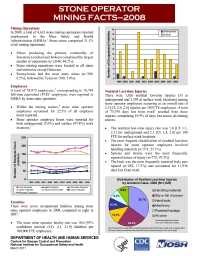Mining Publication: Nonmetal Operator Mining Facts - 2008
Original creation date: March 2011
Mining Operations: In 2008, a total of 720 nonmetal mining operations reported employment to the Mine Safety and Health Administration (MSHA). Nonmetal mines comprised 4.8% of all mining operations. 1. Mines producing clay (including common, ceramic & refractory, fire and not elsewhere classified) comprised 41.0% (n=295) of all nonmetal mining operations. 2. Nonmetal mining operations were located in all states and territories except Alaska, Delaware, Hawaii, New Hampshire, Rhode Island, Puerto Rico, and the U.S. Virgin Islands. Employees: A total of 23,033 employees, corresponding to 23,260 full-time equivalent (FTE) employees, were reported to MSHA by nonmetal mine operators. 1. Within the mining sectors, nonmetal mine operator employees accounted for 6.8% of all employee hours reported. 2. Employee hours were reported at underground (11.7%) and surface (88.3%) work locations. Fatalities: There were two occupational fatalities among nonmetal mine operators in 2008. Nonfatal Lost-time Injuries: There were 507 nonfatal lost-time injuries (95 at underground and 412 at surface work locations) among nonmetal mine operator employees occurring at an overall rate of 2.5 [95% confidence interval (CI): 2.3, 2.8] injuries per 100 FTE employees. A total of 23,708 days lost from work resulted from these injuries. 1. The underground nonfatal lost-time injury rate was greater than the surface injury rate (3.5 [CI: 2.8, 4.3] vs. 2.4 [CI: 2.2, 2.6] per 100 FIE workers). 2. In 2008, the most frequent classification of nonfatal lost-time injuries involved handling materials (n=187; 36.9%), followed by slip or fall of person (n=148; 29.2%). 3. Sprains and strains were the most frequently reported nature of injury (n=230; 45.4%), followed by fracture or chip (n=79; 15.6%). 4. The back was the most frequently reported body part injured (n=89; 17.6%) and accounted for 3,057 days lost from work. This is followed by fingers (n=70; 13.8%) and accounted for 2,286 days lost from work.
Authors: National Institute for Occupational Safety and Health
Brochure/flyer - March 2011
NIOSHTIC2 Number: 20039161
Pittsburgh, PA: U. S. Department of Health and Human Services, Public Health Service, Centers for Disease Control and Prevention, National Institute for Occupational Safety and Health, DHHS (NIOSH) Publication No. 2011-165, 2011 Mar; :1-2
See Also
- Coal Operator Mining Facts - 2005
- Metal Operator Mining Facts - 2002
- Metal Operator Mining Facts - 2004
- Metal Operator Mining Facts - 2005
- Noncoal Contractor Mining Facts - 2003
- Nonmetal Operator Mining Facts - 2002
- Sand and Gravel Operator Mining Facts - 2006
- Stone Operator Mining Facts - 2003
- Stone Operator Mining Facts - 2005
- Underground and Surface Mining Facts - 2004
- Page last reviewed: 9/21/2012
- Page last updated: 9/21/2012
- Content source: National Institute for Occupational Safety and Health, Mining Program


 ShareCompartir
ShareCompartir
